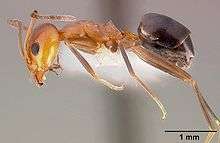Dorymyrmex bicolor
| Dorymyrmex bicolor | |
|---|---|
 | |
| Dorymyrmex bicolor worker | |
| Scientific classification | |
| Kingdom: | Animalia |
| Phylum: | Arthropoda |
| Class: | Insecta |
| Order: | Hymenoptera |
| Family: | Formicidae |
| Subfamily: | Dolichoderinae |
| Genus: | Dorymyrmex |
| Species: | D. bicolor |
| Binomial name | |
| Dorymyrmex bicolor Wheeler, 1906 | |
Dorymyrmex bicolor is a species of ant in the Dolichoderinae subfamily. Dorymyrmex bicolor was recently known as Conomyrma bicolor but has been renamed to Dorymyrmex bicolor.[1] Dorymyrmex bicolor has a single petiole and a slit-like orifice which releases chemical compounds. This ant does not have the capability to sting. Dorymyrmex bicolor is found in arid regions spanning from West Texas to Southern California.[2]
Tool use
Dorymyrmex bicolor regularly interacts with three different species of Myrmecocystus, another genus of ants. Between the two genera of ants, in the southwestern region, there is much overlap of food sources and space between Dorymyrmex bicolor and Myrmecocystus. The Myrmecocystus ants secrete a substance from their poison gland onto a food source they find in order to repel other ants.Dorymyrmex bicolor exhibits a different type of interference behavior. The workers of Dorymyrmex bicolor will surround the entrance to a nest of Myrmecocystus and will drop stones and other objects down the entrance, in an attempt to block the entrance. As many as 10-30 workers of Dorymyrmex bicolor have been observed to drop stones in an opposing nest, but only 5 workers are required to drop stones and other small objects at an efficient rate that will affect the Myrmecocystus nest. The number of Dorymyrmex bicolor workers in an area will have a reducing effect on the number of Myrmecocystus workers in an area, sometimes to drastic effects.[2]
References
- ↑ http://www.antweb.org/description.do?name=bicolor&genus=dorymyrmex&rank=species&project=utahants
- 1 2 Moglich, Michael HG; Alpert, Gary D. (1979). "Stone Dropping by Conomyrma Bicolor: A New Technique of Interference Competition". Behavioral Ecology and Sociobiology. 6 (2): 105–113. doi:10.1007/bf00292556. JSTOR 4599265.
External links
 Media related to Dorymyrmex bicolor at Wikimedia Commons
Media related to Dorymyrmex bicolor at Wikimedia Commons